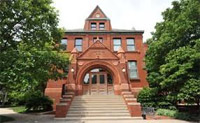Architecture, College of

Masters in Architecture Program: Theses
First Advisor
Jason Griffiths
Date of this Version
Spring 4-29-2019
Document Type
Thesis
Citation
Craig, Holly R., "The Experience Condition: Experiencing Alternate Futures." (2019). Theses from the Architecture Program, University of Nebraska.
Abstract
A B S T R A C T I n t r o In The Human Condition, Hannah Arendt states that the human capacity for new beginnings is marked by the launch of the first satellite into space in 1957. Arendt recognizes this as an ‘event, second in importance to no other, not even to the splitting of the atom’. The minatory threat of technological enterprises, the advent of automation, virtual and cosmic colonization, climatic changes, and todestrieb or ‘death drive,’ belong to a scope of events that impel new forms of experiences. (1)(2)(3) Narrative Architecture will be used as the framework for the representation of the project. As proven in history, by generating a critique through multimedia exploration, Narrative Architecture has the capacity to generate significant contributions to the field of architecture by means of alternative scenarios and architectural visions of the future. In this way, this thesis develops narratives exploring the ‘alternate experiences’ and the parallel between historic experiences and newest experiences that offers different scenarios for living, translated as architectural elements and spatial constructs.(4)(5) Following this dialectic between historic and newest experiences, Architecture becomes a result of visions of alternate futures as a reflection of the human condition and de-construction of myth. M e t h o d o l o g y Divided in two parts; this thesis will start with the research of our ‘historic and newest experiences’ and what they may offer in propositions that render architectural elements and space. By studying archival material, I will observe and analyze seminal ideal projects and dissect works inhabiting the perceptional threshold between physical and virtual domains. The second part of this thesis will evaluate how, shaped by the spectrum of ‘experience types,’ architecture may propose scenarios for living as avatars of space and virtual existence. In its final form, the project will be presented as a multi-media installation of texts, images, objects and moving images, articulating alternate environments of The Experience Condition.
F o o t n o t e s
(1) Hannah Arendt, Human Condition. 2nd ed. (Chicago: University of Chicago Press, 1998).
(2) ‘Minatory threats,’ to include technological enterprises, the advent of automation, virtual and cosmic colonization, climatic changes, and todestrieb or “death drive,” as a scope of events that impel new forms of experiences.
(3) ‘Todestreib,’ or ‘death drive’ is a concept discussed by Slovenian philosopher Slavoj Zizek. Originally proposed by Sabina Spielrein in her paper “Destruction as the Cause of Coming Into Being,” is a psychoanalytical theory suggest that humans drive toward death and self-destruction.
(4) Narrative Architecture is a form of architecture that makes a critique of ideology, rooted in existing research. Through a repertoire of narrative texts, images, moving images and sculpture, it can be used as a tool to critically think about topics affecting our built and natural environments, political and social structures, pasts and futures. Previous examples of these projects are The Post Colonial Room, Exodus or the Voluntary Prisoners of Architecture, Twelve Ideal Cities by Superstudio.
(5)WAI Think Tank, Narrative Architecture Manifesto. www.waithinktank.com/Narrative-Architecture-Manifesto.


Comments
A design thesis Presented to the Faculty of The College of Architecture at the University of Nebraska. In Partial Fulfillment of Requirements for the Degree of Master of Architecture. Under the Supervision of Professor Jason Griffiths, AIA. Major - Architecture, Lincoln, Nebraska.
Copyright (c) 2019 Holly R. Craig